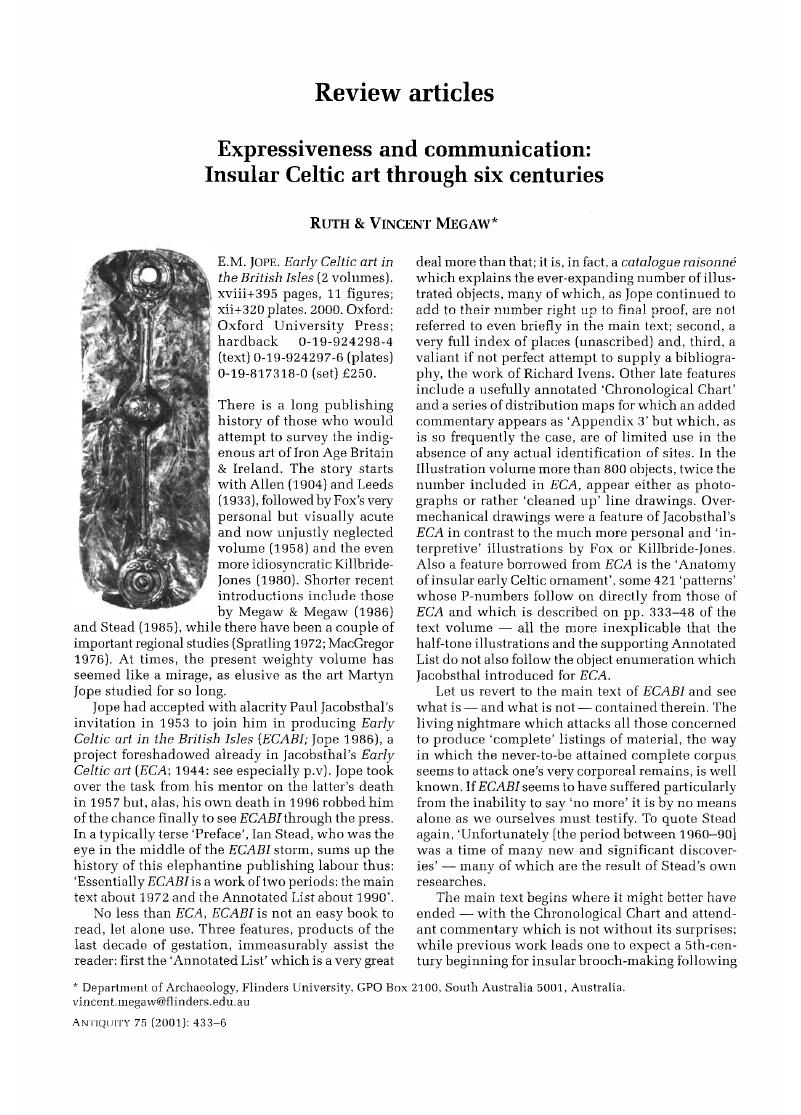Article contents
Expressiveness and communication: Insular Celtic art through six centuries
Published online by Cambridge University Press: 02 January 2015
Abstract
An abstract is not available for this content so a preview has been provided. Please use the Get access link above for information on how to access this content.

- Type
- Review Articles
- Information
- Copyright
- Copyright © Antiquity Publications Ltd. 2001
References
Demarez, L. & Leman-Delerive, G.. In press. A linch-pin of British type found at Blicquy (Hainault, Belgium), Antiquaries Journal 81.Google Scholar
Fox, C.
1958. Pattern and purpose: A survey of early Celtic art in Britain. Cardiff: National Museum of Wales.Google Scholar
Hauteneiive, H.
1999. Les torques tubulaires de Snettisham: importation continentale ou production insulaire? Lunulu: Archaeologia protohistorica (Bruxelles) 7: 89–100.Google Scholar
Jacobsthal, P.F.
1941. Imagery in early Celtic art, Proceedings of the British Academy
27: 301–20
Google Scholar
Jacobsthal, P.F.
1944. Early Celtic art. Oxford: Clarendon Press. (Reprinted with corrections 1969.)Google Scholar
Joachim, H.-E. et al. 1995. Waldalgesheiin: Das Grab einer Fürstín = Kataloge des Rheinischen Landesmuseums Bonn 3. Bonn: Rheinland-Verlag.Google Scholar
Jope, E.M.
1986. Paul Ferdinand Jacobsthal, in Evans, D.E.
Griffith, J.G. & Jope, E.M. (ed.). Proceedings of the Seventh International Congress of Celtic Studies:
15–18. Oxford: Oxbow.Google Scholar
Jope, E.M.
1987. Celtic art: Expressiveness and communication through 2500 years, Proceedings of the British Academy 73:
97–124.Google Scholar
Leeds, E.T.
1933. Celtic ornament in the British Isles down to AD 700. Oxford: Clarendon Press.Google Scholar
Lejars, T. 1994. Gournay III: Les fourreaux d’epee: Le sanctuaire de Gournay-sur-Aronde et l’armement des Celtes de la Tène moyenne. Paris: Errance.Google Scholar
Leman-Delerive, G.
1986. Une plaque emaillee celtique decouverte à Paillart (Oise), Gallia
44: 29–53.Google Scholar
Macgregor, M.
1976. Early Celtic art in North Britain: A study of decorative metalwork from the third century BC to the third century AD. Leicester: Leicester University Press.Google Scholar
Megaw, R. & V. 1986. Early Celtic art in Britain and Ireland. Princes Risborough: Shire Publications. (Revised edition 1994.)Google Scholar
Megaw, R. & V. 1989. Celtic art from its beginnings to the Book of Kells. London: Thames & Hudson (Revised edition 2001.)Google Scholar
Raftery, B.
1994a. Reflections on the Irish scabbard style, in Dobiat, C. (ed.) Festschrift für Otto-Herman Freyzum 65. Geburtstag = Marburger Studien zur Vor- und Friihgeschichte
16: 475–92. Marburg: Hitzeroth.Google Scholar
Raftery, B.
1994b. Pagan Celtic Ireland: The enigma of the Irish Iron Age. London: Thames & Hudson.Google Scholar
Rigby, V., Swadling, J. & Cowell, M.. 1995. The Blandford Forumgroup: are any Etruscan figures true finds from Great Britain and Eire?. in Swadling, J.
Walker, S. & Roberts, P. (ed.), Italy in Europe: economic relations 700 BC-AD 50:
107–30. London: British Museum. British Museum Occasional Paper 97.Google Scholar
Spratlinc, M.G.
1972. Southern British decorated bronzes of the late pre-Roman Iron Age. Unpublished Ph.D thesis, University of London.Google Scholar
Stead, I.M.
1985. Celtic art in Britain before the Roman Conquest. London: British Museum Press. (2nd edition
1996.)Google Scholar
Szabó, M. & Petres, É.F.. 1992. Decorated weapons of the La Tene Iron Age in the Carpathian Basin = Inventaria Praehistorica Hungariae 5. Budapest: Magyar Nemzeti Muzeum.Google Scholar
Watkin, J., Stead, I.M.
Hook, D. & Palmer, S.. 1996. A decorated shield-boss from the River Trent, near Ratcliffe-on-Soar, Antiquaries Journal
76: 17–30.Google Scholar
- 1
- Cited by


